Why combining Mentos and Coke creates a sugary volcano, and other cool candy tricks
Science can be fun — and delicious
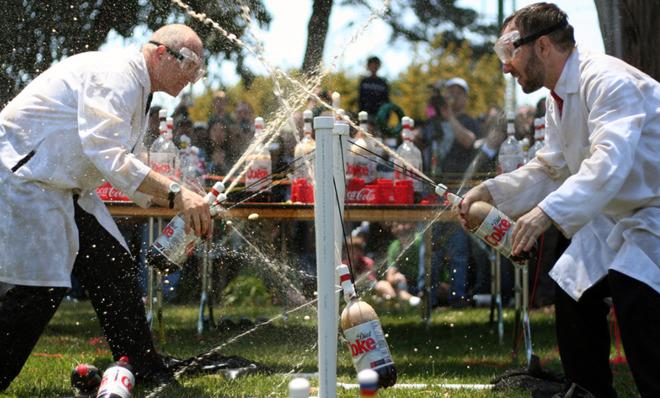
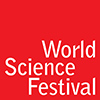
How to make sparks fly in your mouth
We're issuing a science-based exception to the "don't chew with your mouth open" rule for this one. If you crunch Wint-O-Green Life Savers with your mouth open in the dark in front of a mirror, you should see some sparks start to fly. The light you see is due to a phenomenon called "triboluminescence."
When you chomp down on a mint, your teeth are fracturing crystals of sugar. This fracturing happens all the way down at the molecular level, where chemical bonds are broken. Because of the structure of the sugar crystal, the breaking of these chemical bonds causes a build-up of electrons that creates a miniature electrical field. Eventually, the electrons glom onto molecules like oxygen or nitrogen in the air, and emit a bit of light in the process. Usually we can't see this light because it's in the ultraviolet part of the spectrum. But wintergreen candies contain a compound called methyl salicylate that fluoresces, converting that UV light into visible blue light.
The Week
Escape your echo chamber. Get the facts behind the news, plus analysis from multiple perspectives.

Sign up for The Week's Free Newsletters
From our morning news briefing to a weekly Good News Newsletter, get the best of The Week delivered directly to your inbox.
From our morning news briefing to a weekly Good News Newsletter, get the best of The Week delivered directly to your inbox.
(More from World Science Festival: Remembering polio vaccine pioneer Jonas Salk)
Why do Pop Rocks pop?
Carbon dioxide gas is the chemical key to making Pop Rocks crackle in your mouth. Pop Rocks are made by heating a mixture of carbon dioxide and candy (a combination of sugar, corn syrup, lactose, and flavoring) to temperatures above 320 degrees Fahrenheit inside a pressurized chamber. While there's still 600 pounds per square inch of pressure on the mixture, the candy-carbon dioxide combination is cooled. After cooling, the pressure is released and the candy shatters into pieces full of tiny bubbles of carbon dioxide gas.
When you stick some Pop Rocks in your mouth, the candy melts and the carbon dioxide bubbles escape from their sugary prisons with satisfying pops.
A free daily email with the biggest news stories of the day – and the best features from TheWeek.com
And, despite any rumors you might have heard, eating Pop Rocks and drinking soda together won't cause your stomach to explode. That urban legend seems to have spread based on the false notion that pop rocks and soda would combine like an acid and a base and react violently — but since they both just get their fizz from carbon dioxide, the worst thing that would happen to you would be a really big burp.
Why do Mentos and Diet Coke create a geyser?
While you won't get much of a thrill from mixing Pop Rocks and Coke, if you pop some Mentos mints into a bottle of Diet Coke, you'll get to see an impressive geyser:

In some ways, the reaction looks like a science fair volcano. But unlike a baking soda-vinegar geyser, the candy isn't combining with the Coke in an acid-base reaction (none of the ingredients in Mentos are basic). Instead, the Mentos serves as a little factory and launchpad for carbon dioxide bubbles — supercharging the normal bubble-formation process in the Coke. The mint's rough surface has thousands of tiny pores, an ideal landscape for lots of bubbles to form (a process called nucleation). As the bubbles grow they become more buoyant and float up to the top of the soda. The process keeps chugging along, creating more and more bubbles until it explodes out the top of the bottle in a foamy overflow.
Certain ingredients in Mentos, like aspartame and potassium benzoate, also speed the process by acting as surfactants — chemicals that lower the surface tension of the soda. This makes it even easier for bubbles to form on the candy. Too much surface tension in a liquid doesn't allow for much bubble formation — the attractions between molecules in the liquid are strong enough that the molecules at the surface resist moving up and away. Adding a surfactant, like Mentos in Coke or soap in water, loosens the liquid molecules' hold on each other a little bit, allowing for bubbles to form.
Appalachian State University physicist Tonya Coffey wrote an in-depth paper on the science behind the Coke-Mentos reaction published in the American Journal of Physics in 2008. Coffey found that combining Diet Coke and Fruit Mentos yielded the most impressive horizontal spray distance, flinging the soda nearly 17 feet from the bottle.
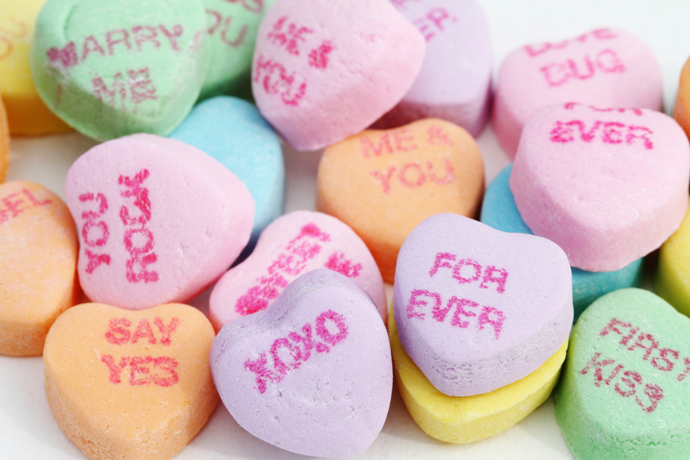
Making candy dance
For a less explosive demonstration of the powers of carbon dioxide fizziness, you can drop a few pieces of various kinds of candy or food into a glass of clear soda and see what happens. Anything with a rough surface — like raisins, or Valentine's Day conversation hearts — should provide a good surface for bubbles to form, as we saw with the Mentos. If the candy (or raisin) is light enough, the carbon dioxide bubbles should be able to buoy it up to the surface; when the bubble pops, the candy (or raisin) falls back down again. This up-and-down "dance" should last until the soda goes flat.
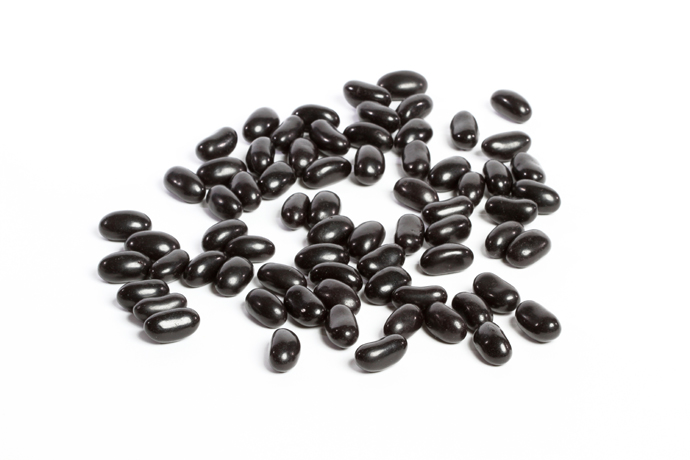
See the spectrum in black jellybeans
Plunk a wet black jellybean down on a piece of filter paper, and you'll be able to see that its blackness is actually made from a combination of hues. The various dyes in the bean will travel different distances away from the jellybean on the filter paper due to their different properties. Some shades of dye are more water-soluble, meaning they dissolve more easily and can be carried along the paper further. Some colors will be more attracted to the paper. The resulting rings of colors are called a separation pattern — something chemists use all the time to figure out what different chemical ingredients are in a mixture. You can try this same experiment with other colors of jellybeans and with other candies as well.
(More from World Science Festival: Getting sleep in the wild)

How to grow giant gummy bears
If you leave gummy bears in tap water for a while, they'll swell up into something more like Gummy Grizzlies. The reason for this is the process of osmosis — the tendency for water to perform a balancing act where it flows from a solution with fewer molecules dissolved into it into a solution that has more molecules in it (provided the two solutions are accessible to each other through a semipermeable membrane that allows certain molecules to cross its border, but which screens out others).
Gummy bears are actually a solution of water. These candies start out as a liquid mixture of water and gelatin, which is heated and then cooled, a process that draws water out of the bear and hardens it into a chewier texture. But there's still some water trapped in the matrix of gelatin that forms the bear. When you stick a gummy bear in water, osmotic pressure forces water molecules into the gummy bear, making the candy swell up like a sponge.
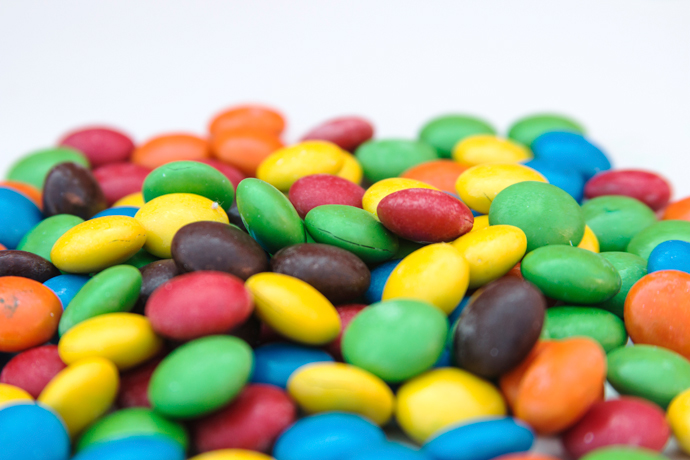
How to take the M off an M&M
If you leave an M&M or a Skittle in water for a little while, the 'M' or 'S' should peel off and float up to the surface. That's because the letters on the candy are made out of white edible ink that doesn't dissolve, unlike the dyes that color the candy shell.
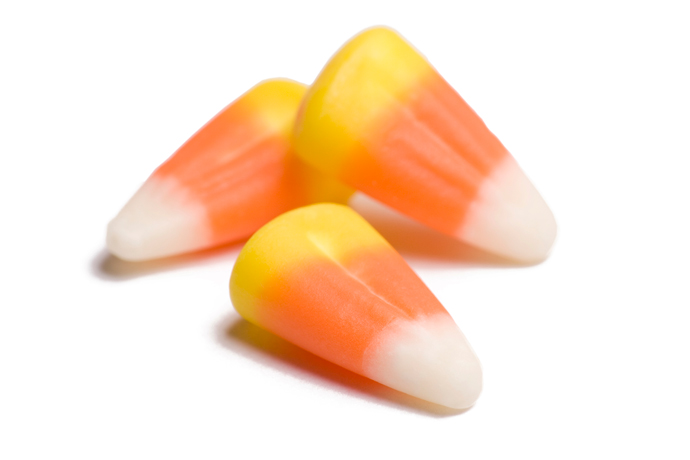
Making soap bubbles with candy corn
This is one experiment you won't be able to do at home, unless you happen to live in a low-gravity environment:
NASA astronaut Don Pettit used his special stash of candy corn on the International Space Station to model how soap works. Soap molecules have a hydrophobic (water-hating) end and a hydrophilic (water-loving) end. When you scrub something with soap, the hydrophobic ends of the soap molecules automatically point towards little globules of grease and oil on your clothes (or your dishes, or your skin); eventually, the particles of grease are encased in little bubbles of soap and can be rinsed off with water.
(More from World Science Festival: How fear happens)
With his candy corn experiment, Pettit did the same trick, but in reverse: He coated one end of his candy corn pieces with oil, making it hydrophobic, then started adding kernels to a floating sphere of water. The hydrophobic ends naturally oriented themselves away from the center. After Pettit added enough candy corn, the sphere reached what's known as the "critical micelle concentration." The candy corn sphere wasn't mushy anymore, but behaved like a solid ball — or like a soap-coated grease globule ready to be rinsed off and away.
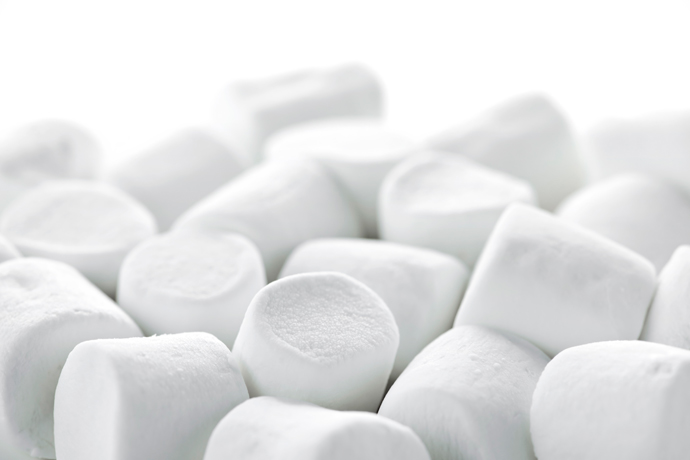
Why microwaved marshmallows puff up
Put a couple marshmallows in the microwave for about a minute, and you'll see them puff up. This is because the heat from the microwave softens the sugar in the marshmallow, and also causes the air pockets inside the sweet to expand. Because the sugary walls of the marshmallow are softer, the marshmallow puffs up. When cooled, the marshmallow shrinks down again — but is usually a bit crunchier than before, probably because some of the water inside it evaporated in the heat of the microwave.

